Shear Behavior and Analytical Method of Vertically Corrugated Steel Plate Shear Walls with Inelastic Buckling of Infilled Plates
Abstract
:1. Introduction
2. Computational Study
2.1. Finite Element Model
2.2. Verification Study
3. Parametric Analyses and Discussions
3.1. Connection Type Effect
3.2. Height–Thickness Ratio Effect
3.3. Aspect Ratio Effect
3.4. Horizontal Subpanel Width Effect
3.5. Surrounding Frame Stiffness Effect
4. Buckling Strength and Section Stiffness of the Inclined Subpanel Effect
5. Simplified Analytical Model
5.1. PFI Model
5.2. Equivalent Bracing Model
6. Conclusions
Author Contributions
Funding
Data Availability Statement
Conflicts of Interest
References
- Wang, W.; Quan, C.-C.; Li, Y.; Zhen, G.-K.; Zhao, H.-T. Experimental study and numerical simulation analysis on seismic performance of corrugated steel-plate shear wall with replaceable bottom corner dampers. Soil Dyn. Earthq. Eng. 2022, 152, 107061. [Google Scholar]
- Kalali, H.; Ghazijahani, T.G.; Hajsadeghi, M.; Zirakian, T.; Alaee, F.J. Numerical study on steel shear walls with sinusoidal corrugated plates. Solids Struct. 2016, 13, 2502–2514. [Google Scholar] [CrossRef]
- Dou, C.; Pi, Y.L.; Gao, W. Shear resistance and post-buckling behavior of corrugated panels in steel plate shear walls. Thin-Walled Struct. 2018, 131, 816–826. [Google Scholar]
- Zhang, W.; Mandavian, M.; Yu, C. Lateral strength and deflection of cold-formed steel shear walls using corrugated sheathing. J. Constr. Steel Res. 2018, 148, 399–408. [Google Scholar] [CrossRef]
- Yu, Y.; Chen, Z. Rigidity of corrugated plate sidewalls and its effect on the modular structural design. Eng. Struct. 2018, 175, 191–200. [Google Scholar]
- Wang, W.; Ren, Y.; Lu, Z.; Song, J.; Han, B.; Zhou, Y. Experimental study of the hysteretic behaviour of corrugated steel plate shear walls and steel plate reinforced concrete composite shear walls. J. Constr. Steel Res. 2019, 160, 136–152. [Google Scholar]
- Zhao, Q.; Qiu, J.; Hao, B.; Hao, B.; Wang, Q. Lateral behaviour of vertically-corrugated Steel plate shear walls connected with beams only. J. Tianjin Univ. (Sci. Technol.) 2019, 2, 46–53. (In Chinese) [Google Scholar]
- Emami, F.; Mofid, M.; Vafai, A. Experimental study on cyclic behaviour of trapezoidally corrugated steel shear walls. Eng. Struct. 2013, 48, 750–762. [Google Scholar]
- Shon, S.; Yoo, M.; Lee, S. An experimental study on the shear hysteresis and energy dissipation of the steel frame with a trapezoidal-corrugated steel plate. Materials 2017, 10, 83–97. [Google Scholar]
- Luo, Q.; Wang, W.; Sun, Z.; Xu, S.; Wang, B. Seismic performance analysis of corrugated-steel-plate composite shear wall based on corner failure. J. Constr. Steel Res. 2021, 180, 106606. [Google Scholar] [CrossRef]
- Kalali, H.; Hajsadeghi, M.; Zirakian, T.; Alaee, F.J. Hysteretic performance of SPSWs with trapezoidally horizontal corrugated web-plates. Steel Compos. Struct. 2015, 19, 277–292. [Google Scholar]
- Farzampour, A.; Mansouri, I.; Lee, C.H.; Sim, H.B.; Hu, J.W. Analysis and design recommendations for corrugated steel plate shear walls with a reduced beam section. Thin-Walled Struct. 2018, 132, 658–666. [Google Scholar]
- Bahrebar, M.; Kabir, M.; Hajsadeghi, M. Structural performance of steel plate shear walls with trapezoidal corrugations and centrally-placed square perforations. Int. Steel Struct. 2016, 16, 845–855. [Google Scholar]
- Hosseinzadeh, L.; Mofid, M.; Aziminejad, A.; Emami, F. Elastic interactive buckling strength of corrugated steel shear wall under pure shear force. Struct. Des. Tall Spec. Build. 2017, 26, e1357. [Google Scholar] [CrossRef]
- Zhao, Q.; Qiu, J.; Zhao, Y.; Cheng, Y. Performance-Based Seismic Design of Corrugated Steel Plate Shear Walls. KSCE J. Civ. Eng. 2022, 26, 3486–3503. [Google Scholar]
- Tong, J.; Guo, Y. Elastic buckling behavior of steel trapezoidal corrugated shear walls with vertical stiffeners. Thin-Walled Struct. 2015, 95, 31–39. [Google Scholar]
- Farzampour, A.; Laman, J.; Mofid, M. Behavior prediction of corrugated steel plate shear walls with openings. Constr. Steel Res. 2015, 114, 258–268. [Google Scholar] [CrossRef]
- Cao, Q.; Huang, J. Experimental study and numerical simulation of corrugated steel plate shear walls subjected to cyclic loads. J. Thin-Walled Struct. 2018, 127, 306–317. [Google Scholar]
- Yan, J.; Ding, Y.; Zong, L.; Li, Z.; Dai, X. Analytical and numerical studies on steel columns with novel connections in modular construction. Int. J. Steel Struct. 2017, 17, 1613–1626. [Google Scholar]
- Deng, E.-F.; Zong, L.; Wang, H.-P.; Shi, F.-W.; Ding, Y. High efficiency analysis model for corrugated steel plate shear walls in modular steel construction. Thin-Walled Struct. 2020, 156, 106963. [Google Scholar]
- Wang, W.; Zhao, T.; Quan, C.; Song, H.L.; Li, Y.; Zhou, Y.X. Shear bearing capacity of vertical corrugated steel plate shear wall with replaceable toe. Zhejiang Daxue Xuebao (Gongxue Ban) 2021, 55, 1407–1418. [Google Scholar]
- Feng, L.; Sun, T.; Ou, J. Elastic buckling analysis of steel-strip-stiffened trapezoidal corrugated steel plate shear walls. J. Constr. Steel Res. 2021, 184, 106833. [Google Scholar] [CrossRef]
- Huang, S. Experimental Study on Seismic Behavior of Corrugated Steel Shear Walls. Ph.D. Thesis, Xi’an University of Archi-tecture and Technology, Xi’an, China, 2019. (In Chinese). [Google Scholar]
- Garbowski, T.; Gajewski, T.; Grabski, J.K. Role of Transverse Shear Modulus in the Performance of Corrugated Materials. Materials 2020, 13, 3791. [Google Scholar] [PubMed]
- Garbowski, T.; Gajewski, T.; Grabski, J. The Role of Buckling in the Estimation of Compressive Strength of Corrugated Cardboard Boxes. Materials 2020, 13, 4578. [Google Scholar] [PubMed]
- Marek, A.; Garbowski, T. Homogenization of sandwich panels. Comput. Assist. Methods Eng. Sci. 2015, 22, 39–50. [Google Scholar]
- Mrówczyński, D.; Knitter-Piątkowska, A.; Garbowski, T. Non-Local Sensitivity Analysis and Numerical Homogenization in Optimal Design of Single-Wall Corrugated Board Packaging. Materials 2022, 15, 720. [Google Scholar]
- Staszak, N.; Gajewski, T.; Garbowski, T. Shell-to-Beam Numerical Homogenization of 3D Thin-Walled Perforated Beams. Materials 2022, 15, 1827. [Google Scholar] [CrossRef]
- Staszak, N.; Garbowski, T.; Szymczak-Graczyk, A. Solid Truss to Shell Numerical Homogenization of Prefabricated Composite Slabs. Materials 2021, 14, 4120. [Google Scholar] [CrossRef]
- Biancolini, M. Evaluation of equivalent stiffness properties of corrugated board. Materials 2005, 69, 322–328. [Google Scholar] [CrossRef]
- Garbowski, T.; Jarmuszczak, M. Homogenization of corrugated paperboard. Part 1. Analytical homogenization. Pol. Pap. Rev. 2014, 70, 345–349. (In Polish) [Google Scholar]
- Garbowski, T.; Jarmuszczak, M. Homogenization of corrugated paperboard. Part 2. Numerical homogenization. Pol. Pap. Rev. 2014, 70, 390–394. (In Polish) [Google Scholar]
- Wu, Q.; Chen, H.; Gao, W. Nonlocal strain gradient forced vibrations of FG-GPLRC nanocomposite microbeams. Eng. Comput. 2020, 36, 1739–1750. [Google Scholar] [CrossRef]
- Fan, F.; Kiani, K. A rigorously analytical exploration of vibrations of arbitrarily shaped multi-layered nanomembranes from different materials. Int. J. Mech. Sci. 2021, 206, 106603. [Google Scholar]
- Kiani, K.; Pakdaman, H. On the nonlocality of bilateral vibrations of single-layered membranes from vertically aligned double-walled carbon nanotubes. Phys. Scr. 2020, 95, 035221. [Google Scholar] [CrossRef]
- Karimiasl, M.; Ebrahimi, F.; Mahesh, V. On nonlinear vibration of sandwiched polymer- CNT/GPL-fiber nanocomposite nanoshells. Thin-Walled Struct. 2020, 146, 106431. [Google Scholar] [CrossRef]
- Kiani, K.; Pakdaman, H. Bilaterally nonlocal dynamics of layer-by-layer assembly of double-walled carbon nanotubes accounting for intertube rigorous van der Waals forces. Eur. J. Mech. A/Solids 2020, 80, 103876. [Google Scholar] [CrossRef]
- Yuan, Y.; Zhao, K.; Zhao, Y.; Kiani, K. Nonlocal-integro-vibro analysis of vertically aligned monolayered nonuniform FGM nanorods. Steel Compos. Struct. 2020, 37, 551–569. [Google Scholar]
- Tong, J.; Chen, P.; Zhao, J.; Zhao, B. Fracture test of nanocomposite ceramics under ultrasonic vibration based on nonlocal theory. Ceram. Int. 2019, 45, 528–537. [Google Scholar] [CrossRef]
- Yu, G.; Kiani, K.; Roshan, M. Dynamic analysis of multiple-nanobeam-systems acted upon by multiple moving nanoparticles accounting for nonlocality, lag, and lateral inertia. Appl. Math. Model. 2022, 108, 326–354. [Google Scholar] [CrossRef]
- Kiani, K. Nonlocal and shear effects on column buckling of single-layered membranes from stocky single-walled carbon nanotubes. Compos. B Eng. 2015, 79, 535–552. [Google Scholar] [CrossRef]
- Tocci, M.; Fantuzzi, N.; Fabbrocino, F.; Luciano, R. Hygro-thermal vibrations and buckling of laminated nanoplates via nonlocal strain gradient theory. Compos. Struct. 2021, 262, 197–206. [Google Scholar]
- Kiani, K. Free vibration of in-plane-aligned membranes of single-walled carbon nanotubes in the presence of in-plane-unidirectional magnetic fields. JVC/J. Vib. Control. 2016, 22, 3736–3766. [Google Scholar] [CrossRef]
- Kiani, K. Nonlocal free dynamic analysis of periodic arrays of single-walled carbon nanotubes in the presence of longitudinal thermal and magnetic fields. Comput. Math. Appl. 2018, 75, 3849–3872. [Google Scholar] [CrossRef]
- Zhao, Q.; Qiu, J.; Li, N.; Li, Z. Experimental study on seismic performance of trapezoidally corrugated steel plate shear walls. J. Build. Struct. 2018, 39, 112–120. [Google Scholar]
- GB 50011; Code for Seismic Design of Buildings. China Ministry of Construction: Beijing, China, 2010. (In Chinese)
- Montgomery, C.; Medhekar, M.; Lubell, A.; Prion, H.G.L.; Ventura, C.E.; Rezai, M. Unstiffened steel plate shear wall performance under cyclic loading. Struct. Eng. 2001, 127, 973–975. [Google Scholar] [CrossRef]
- Yi, J.; Gil, H.; Youm, K.; Lee, H. Interactive shear buckling behaviour of trapezoidally corrugated steel webs. Eng. Struct. 2008, 30, 1659–1666. [Google Scholar]
- John, T.D.; Easley, B. Buckling of light-gage corrugated metal shear diaphragms. Struct. Div. 1969, 95, 3004–3006. [Google Scholar]
- Shen, Y.; Chen, Y.; Chen, Y. Steel Structures; Science Press: Beijing, China, 2005. [Google Scholar]
- JGJ/T 380-2015; Technical Specification for Steel Plat Shear Walls. China Ministry of Construction: Beijing, China, 2015. (In Chinese)
- Sabouri-Ghomi, S.; Ventura, C.; Kharrazi, M. Shear Analysis and Design of Ductile Steel Plate Walls. J. Struct. Eng. 2005, 131, 878–889. [Google Scholar] [CrossRef]
- Berman, J.; Bruneau, M. Plastic Analysis and Design of Steel Plate Shear Walls. J. Struct. Eng. 2003, 129, 695–697. [Google Scholar] [CrossRef]
- Shishkin, J.; Ver, R.; Grondin, G. Analysis of Steel Plate Shear Walls Using the Modified Strip Model; Department of Civil and Environmental Engineering, University of Alberta: Edmonton, AB, Canada, 2005. [Google Scholar]

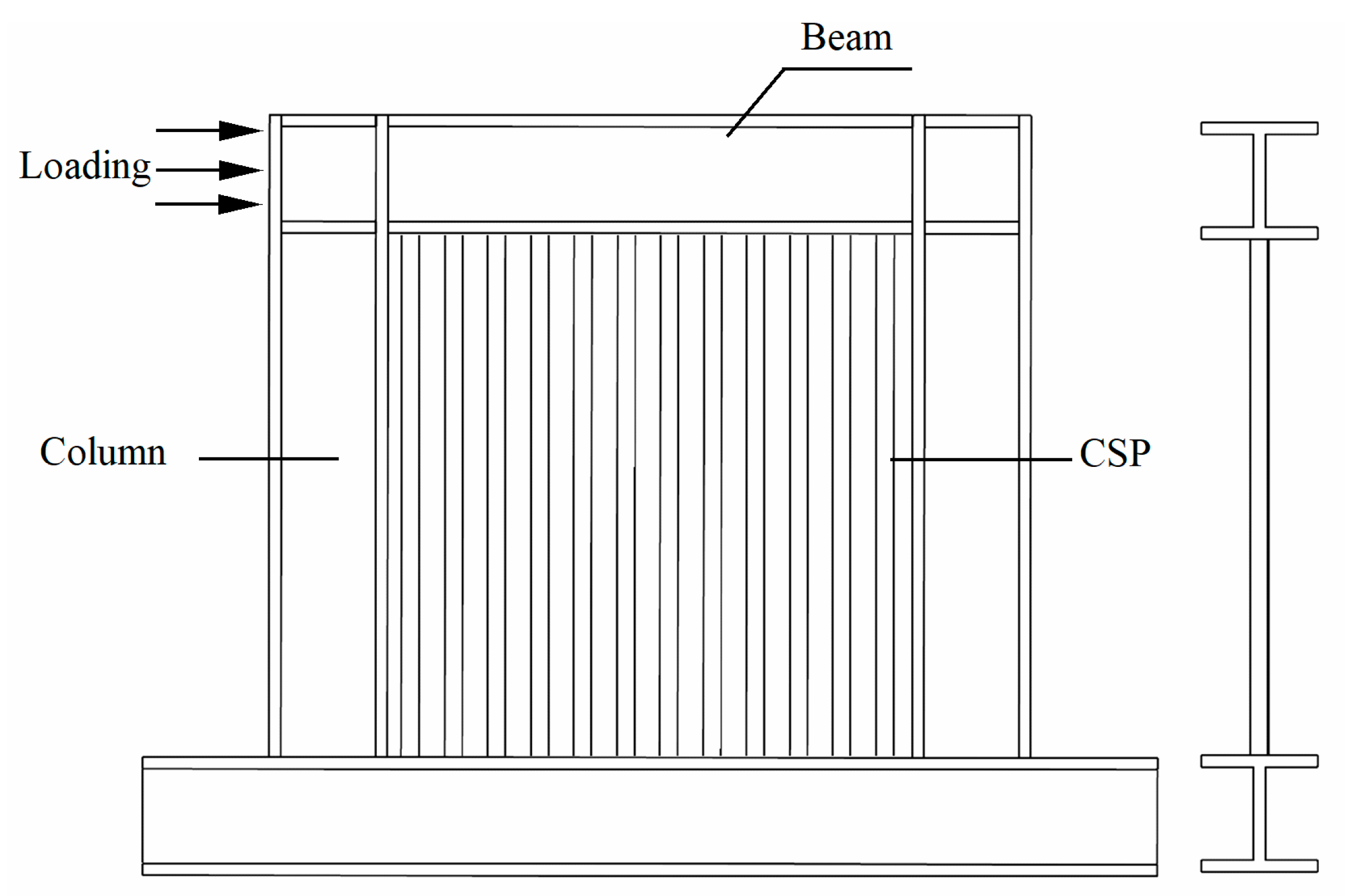

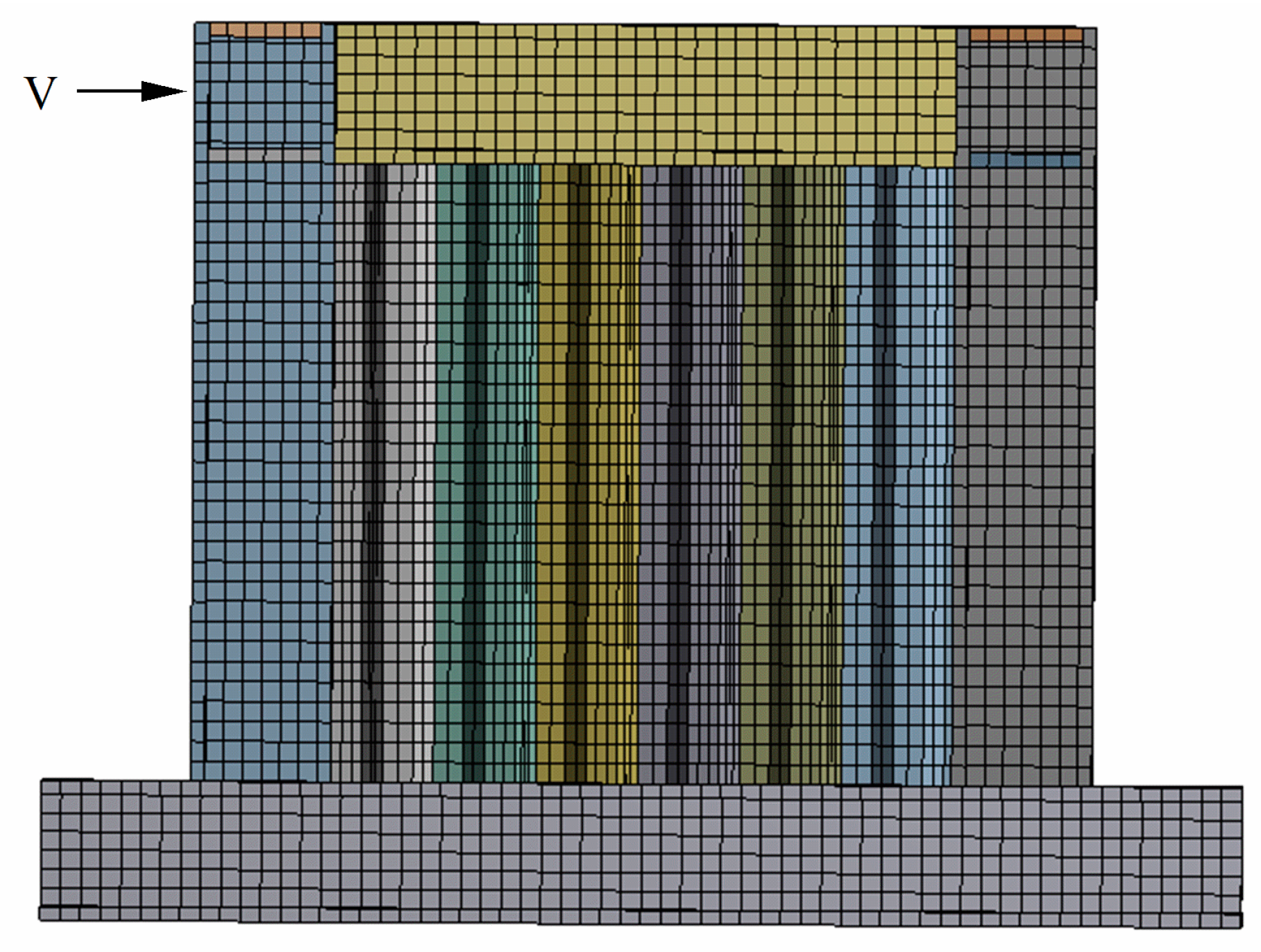


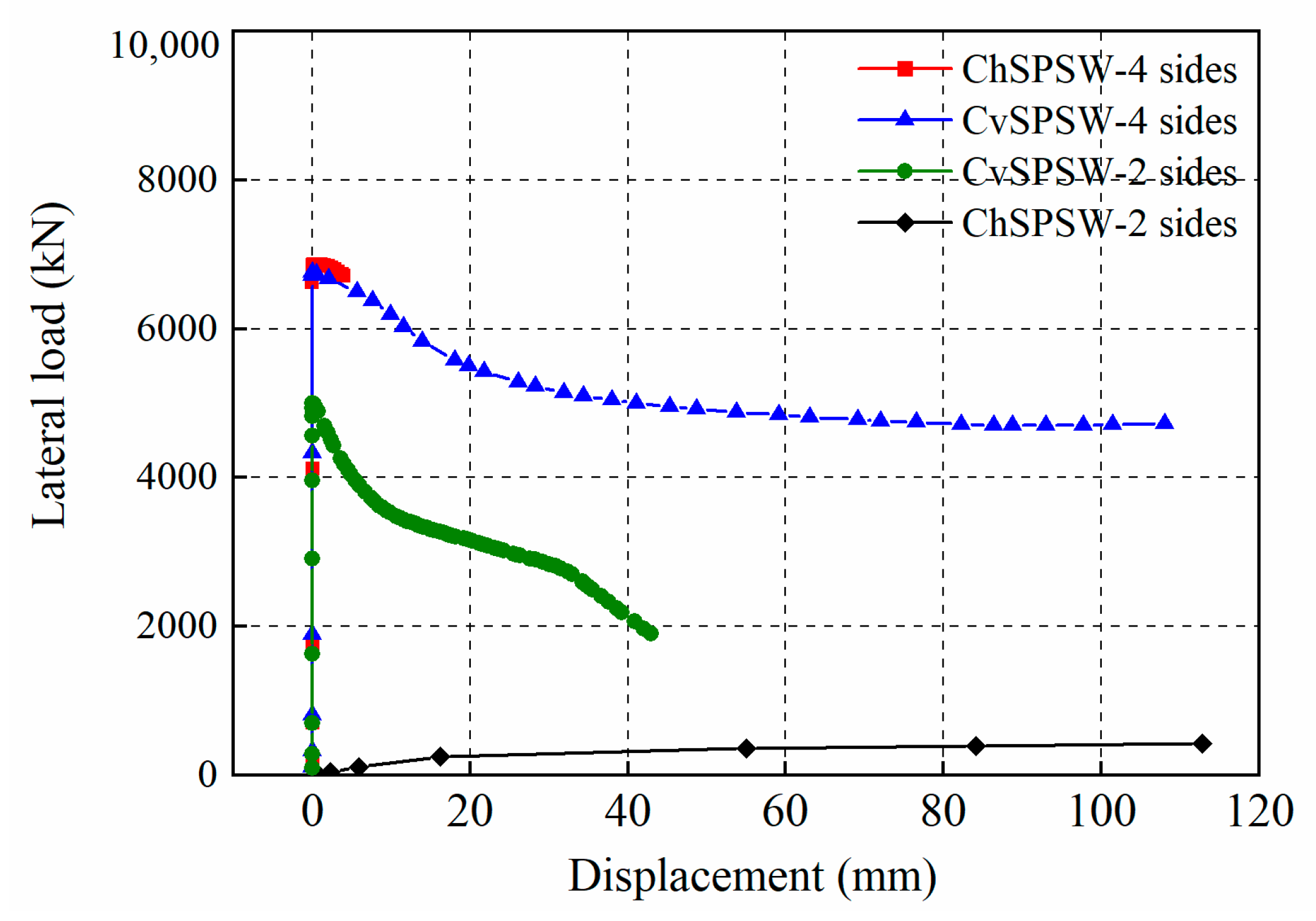



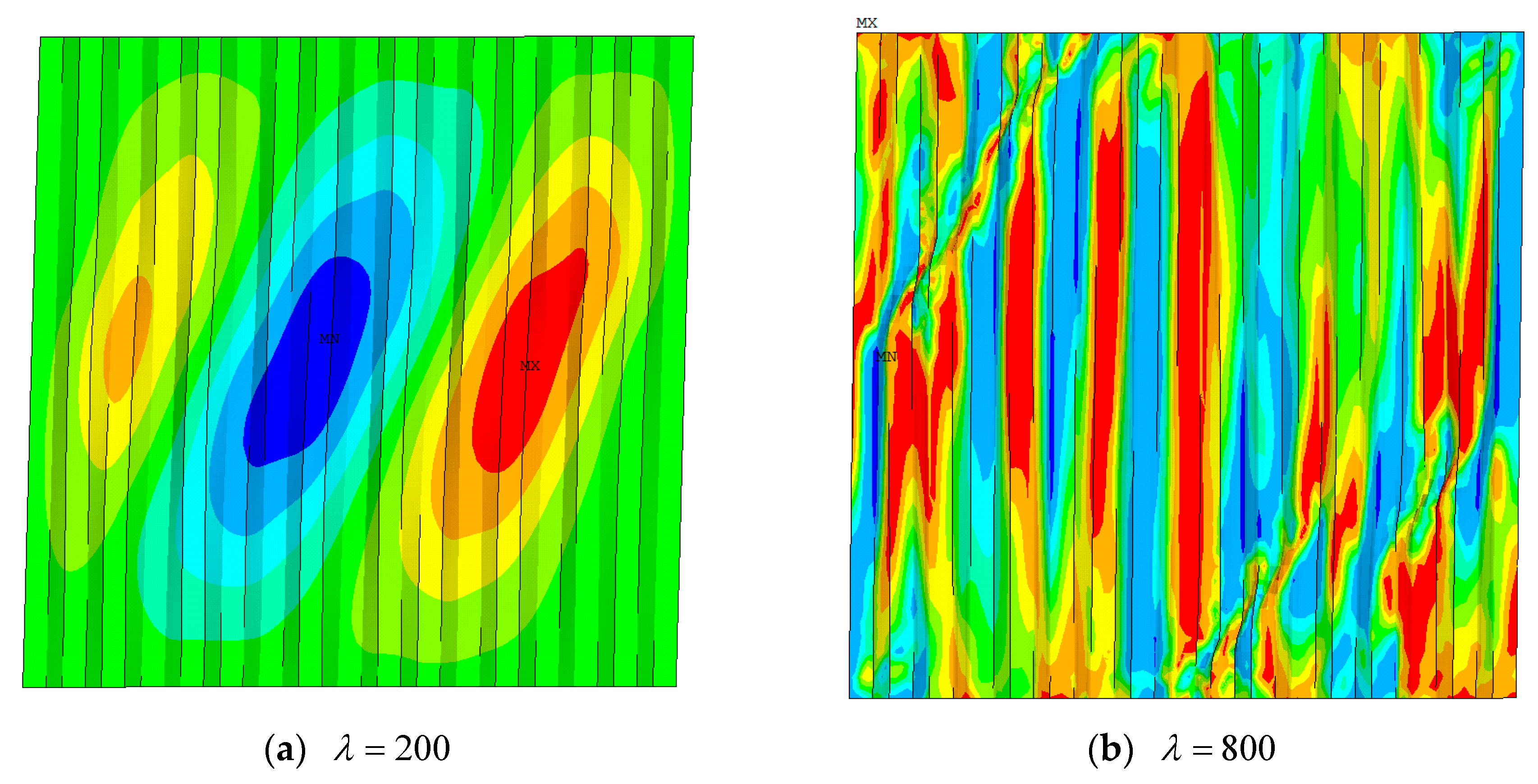




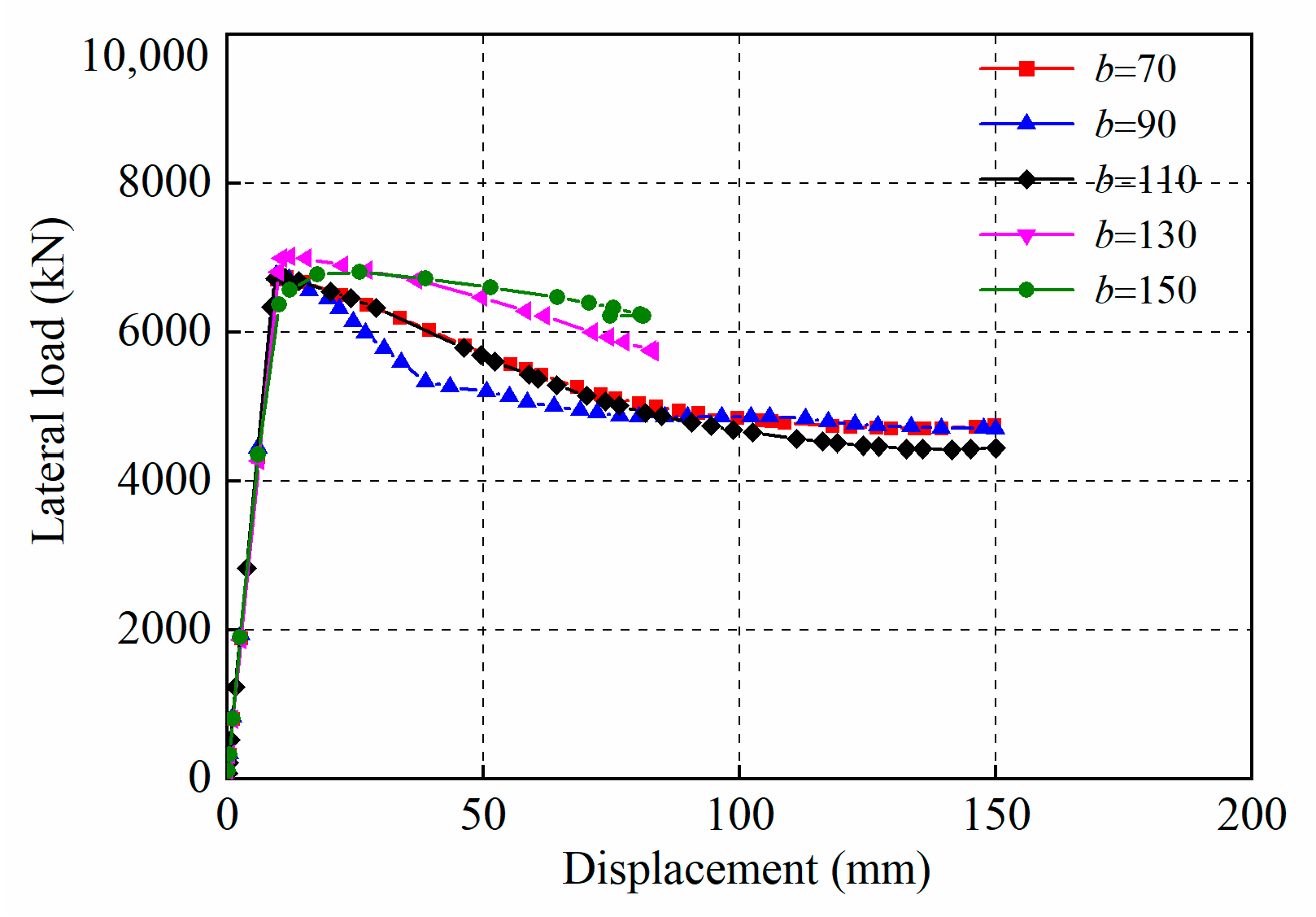

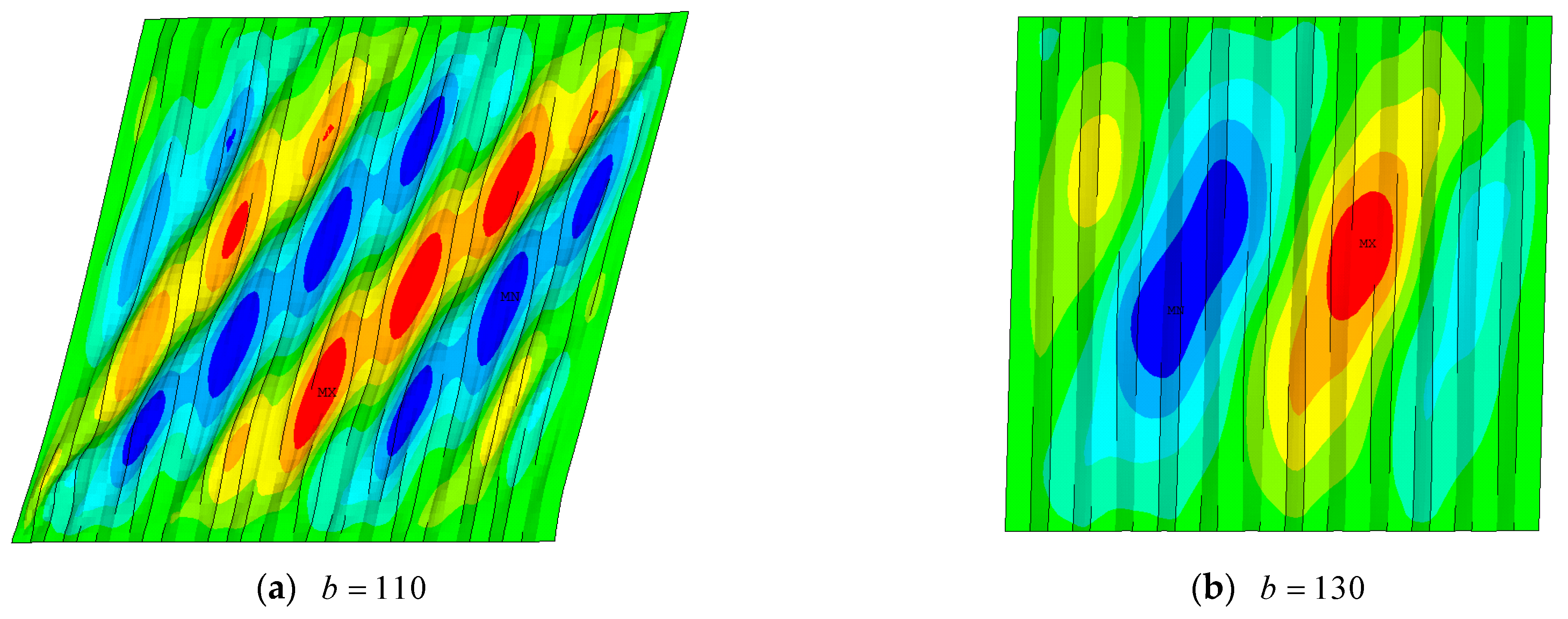
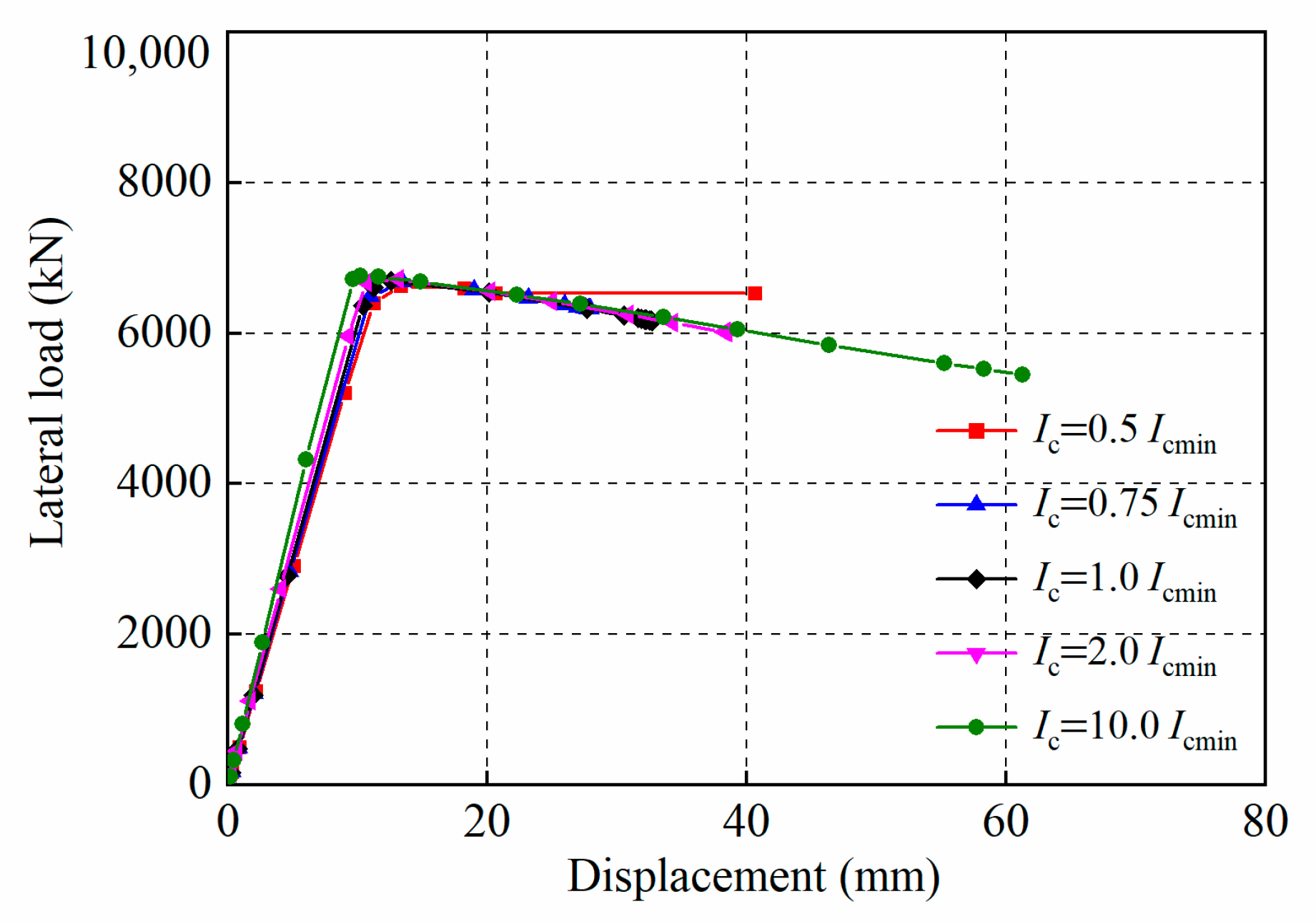
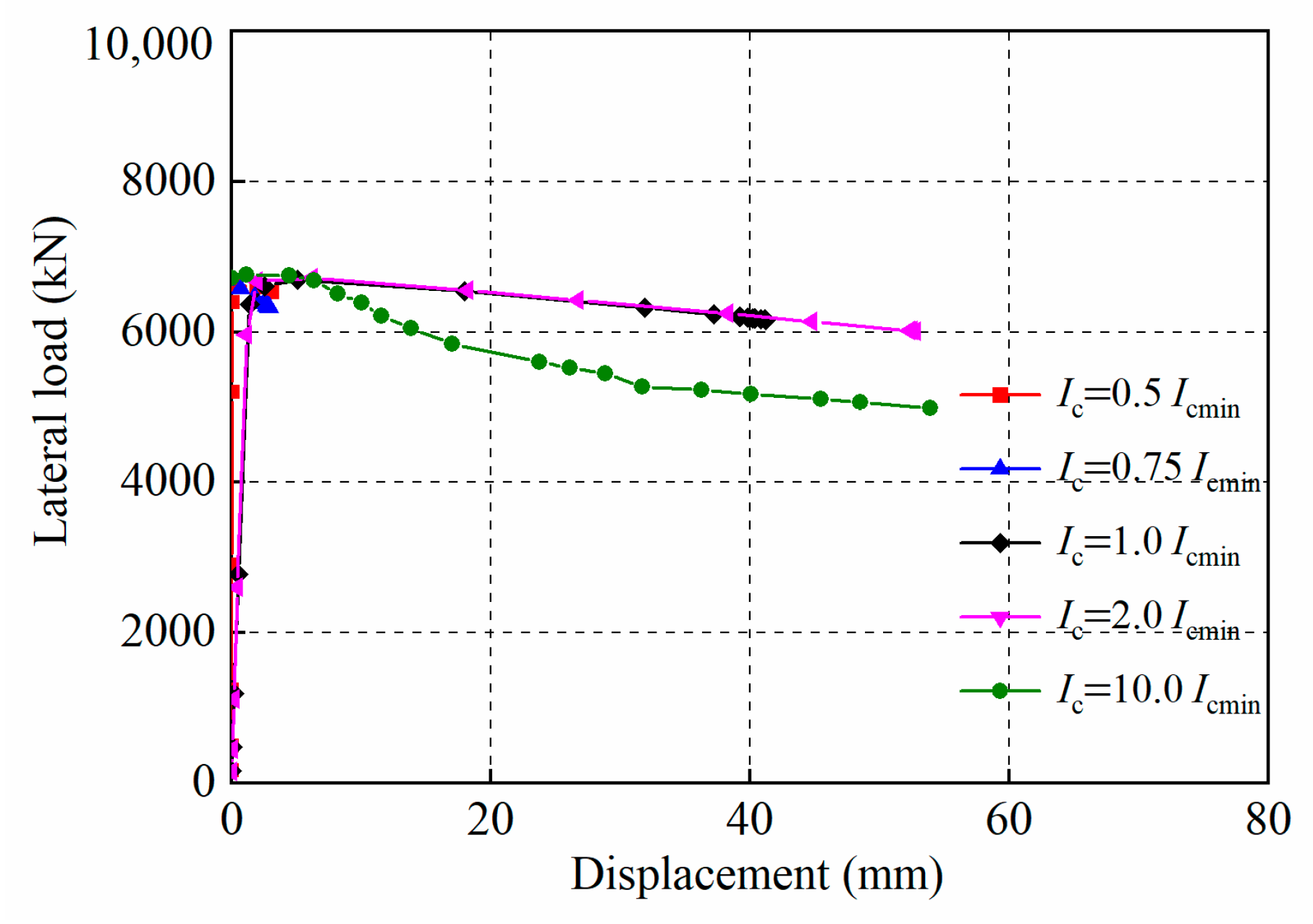

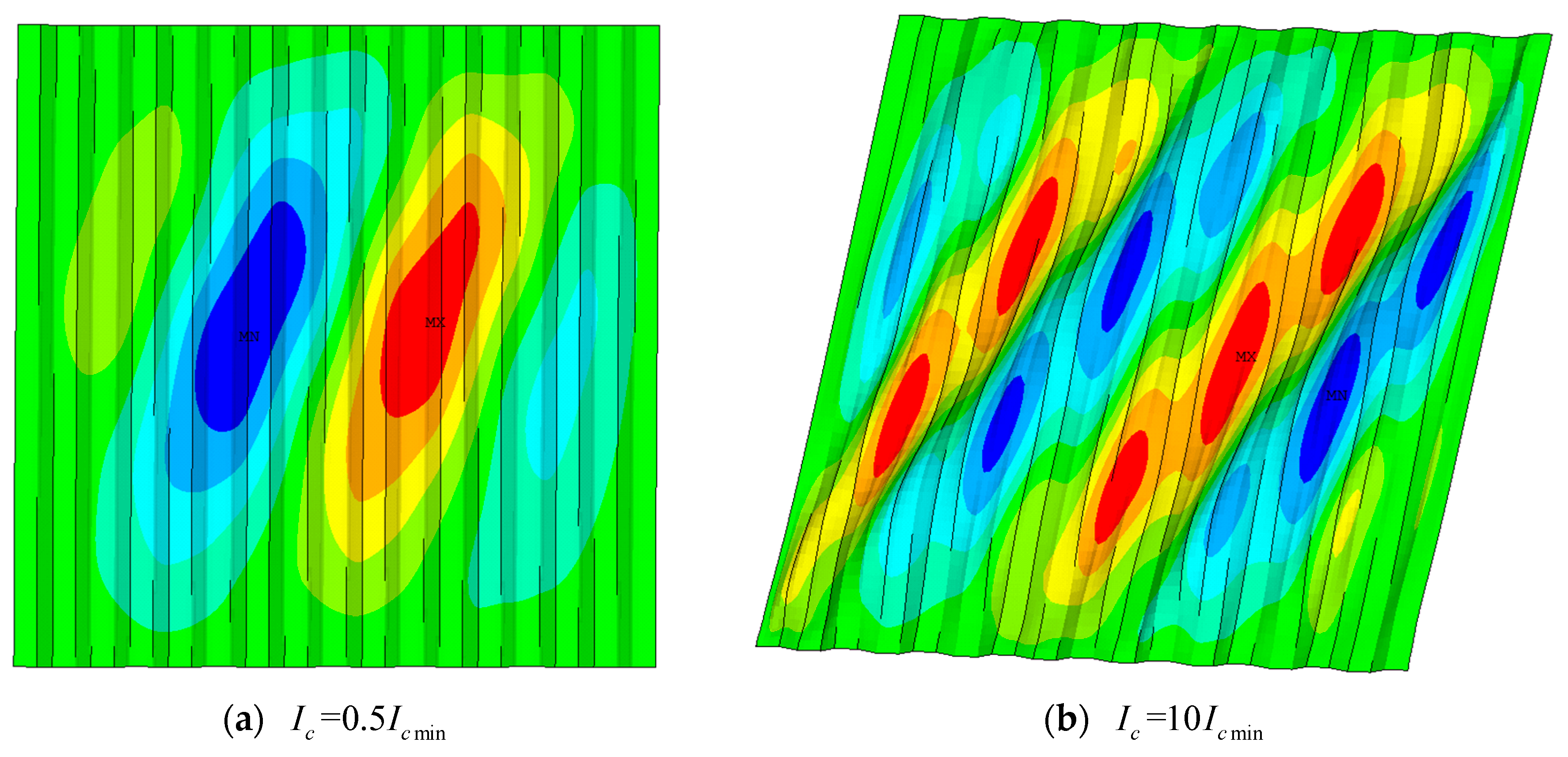
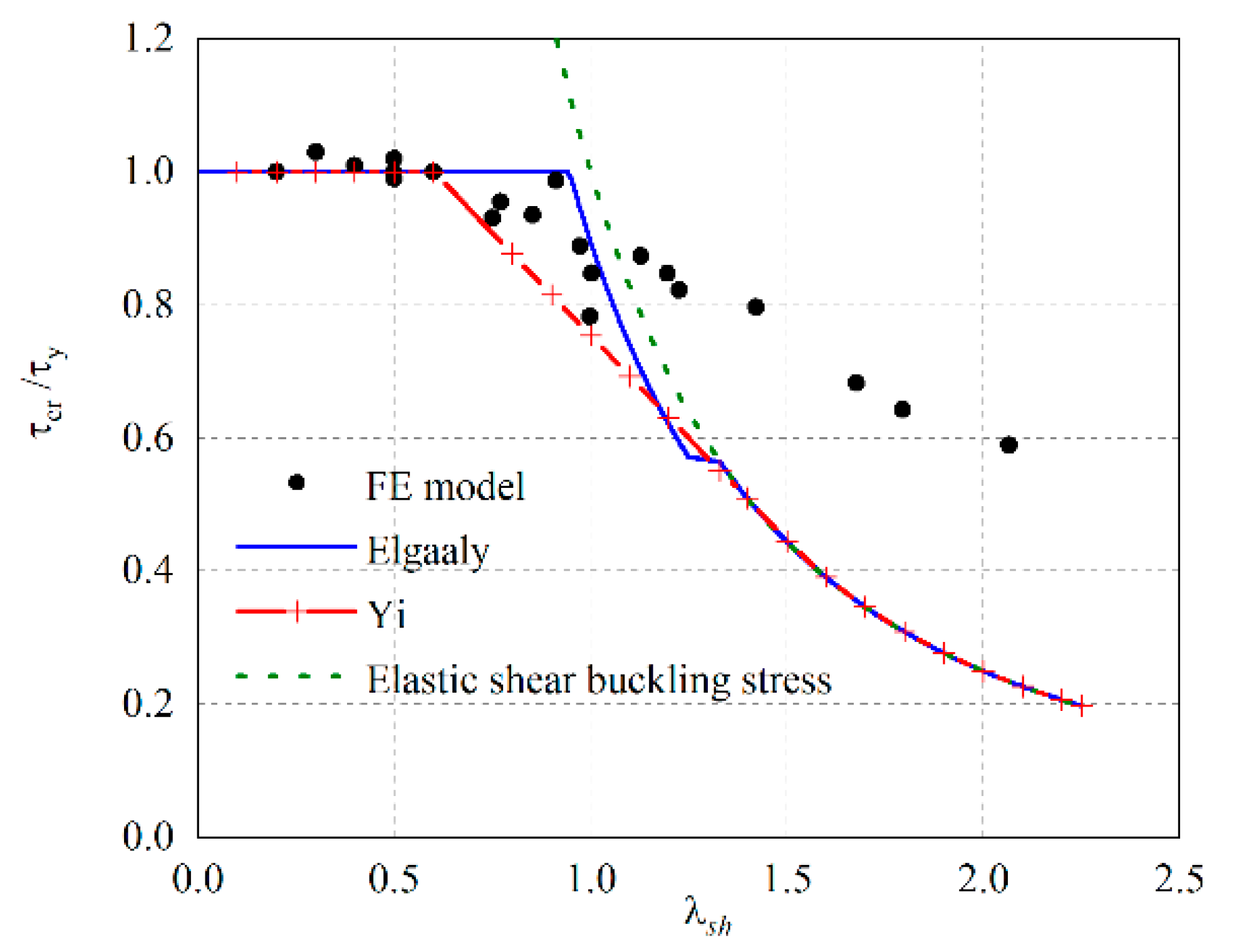
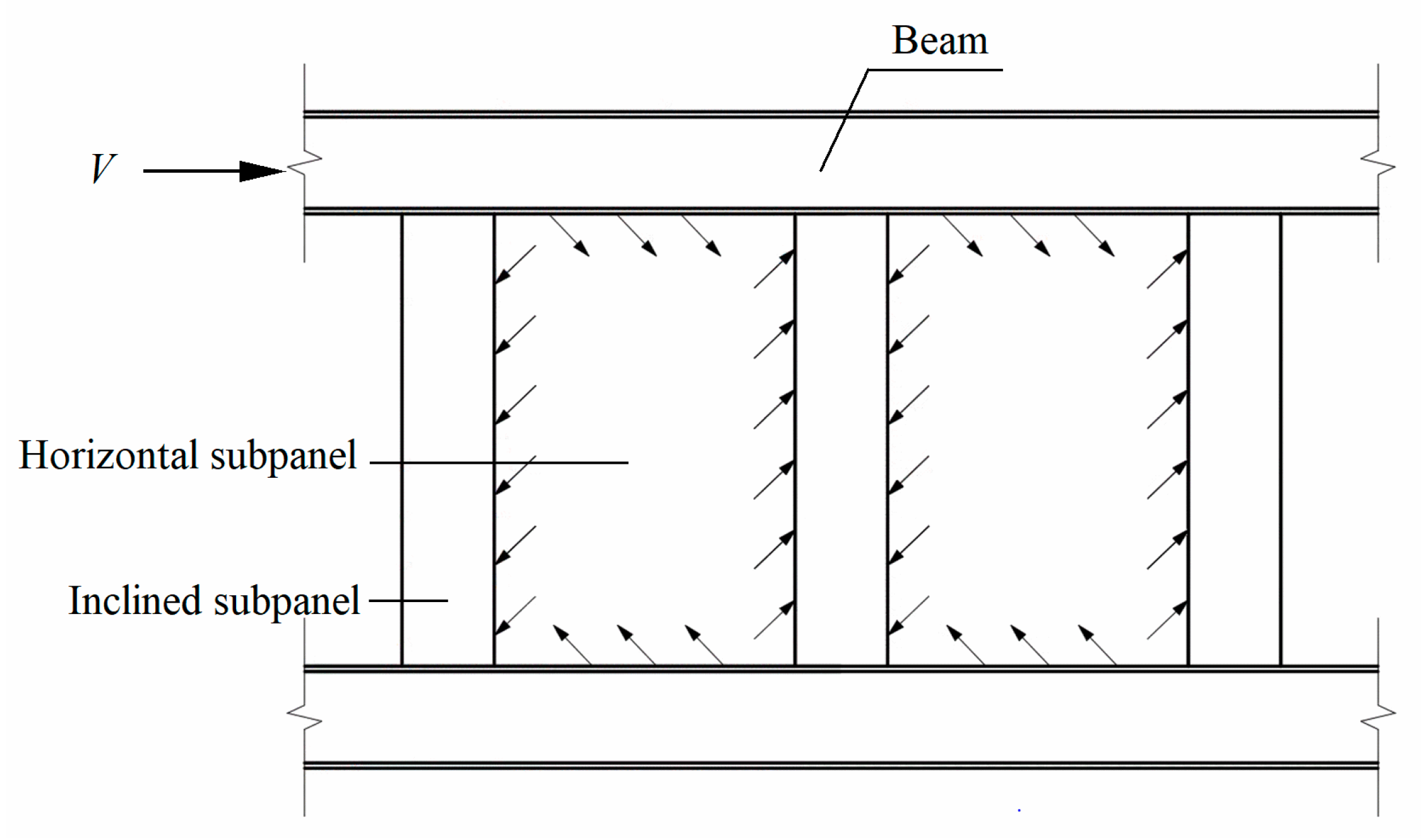
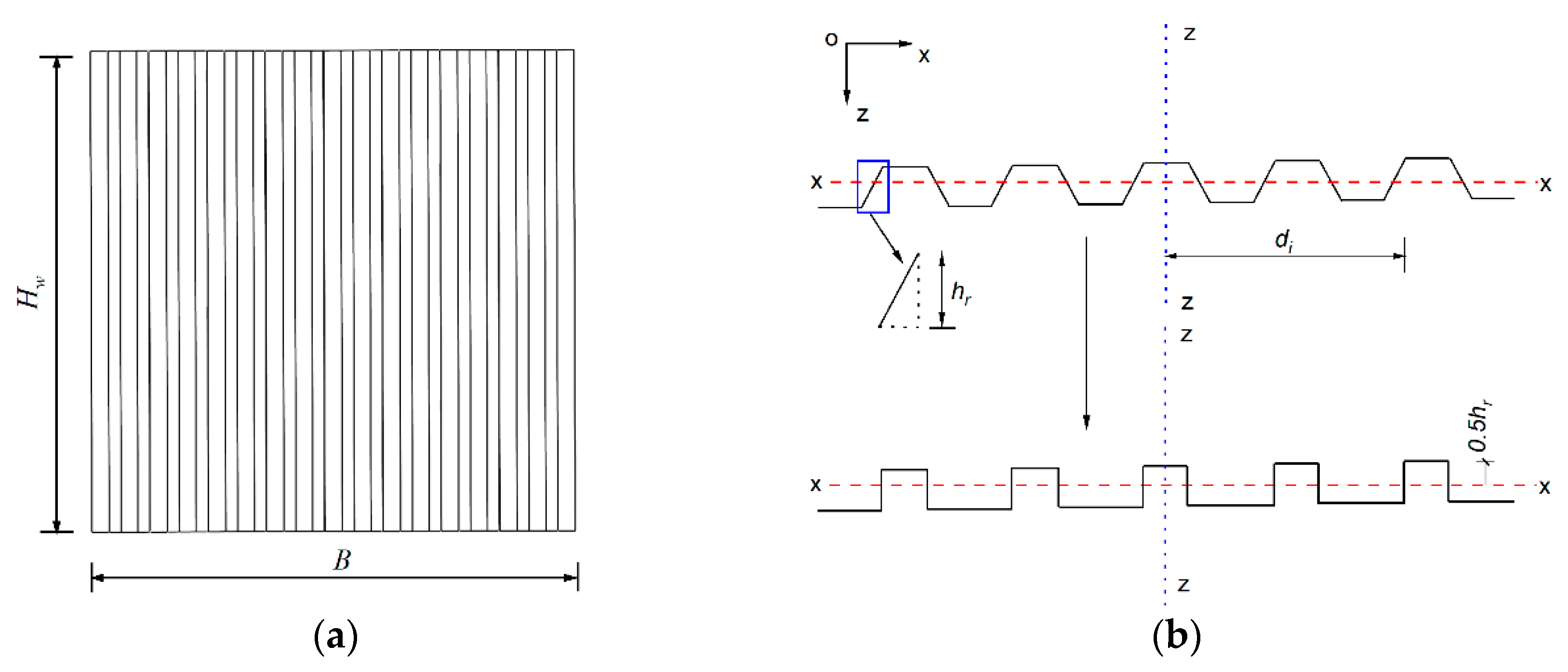

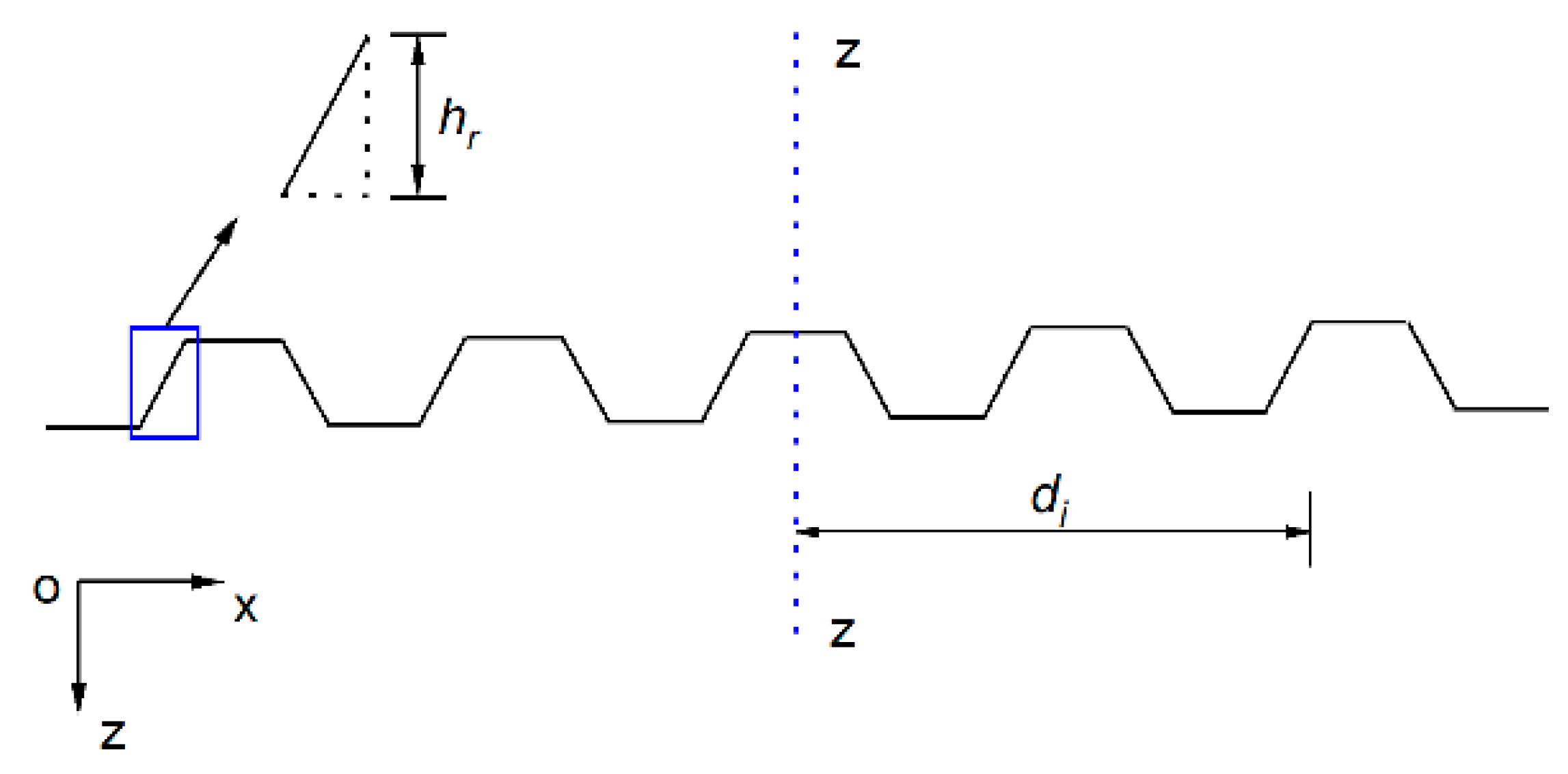


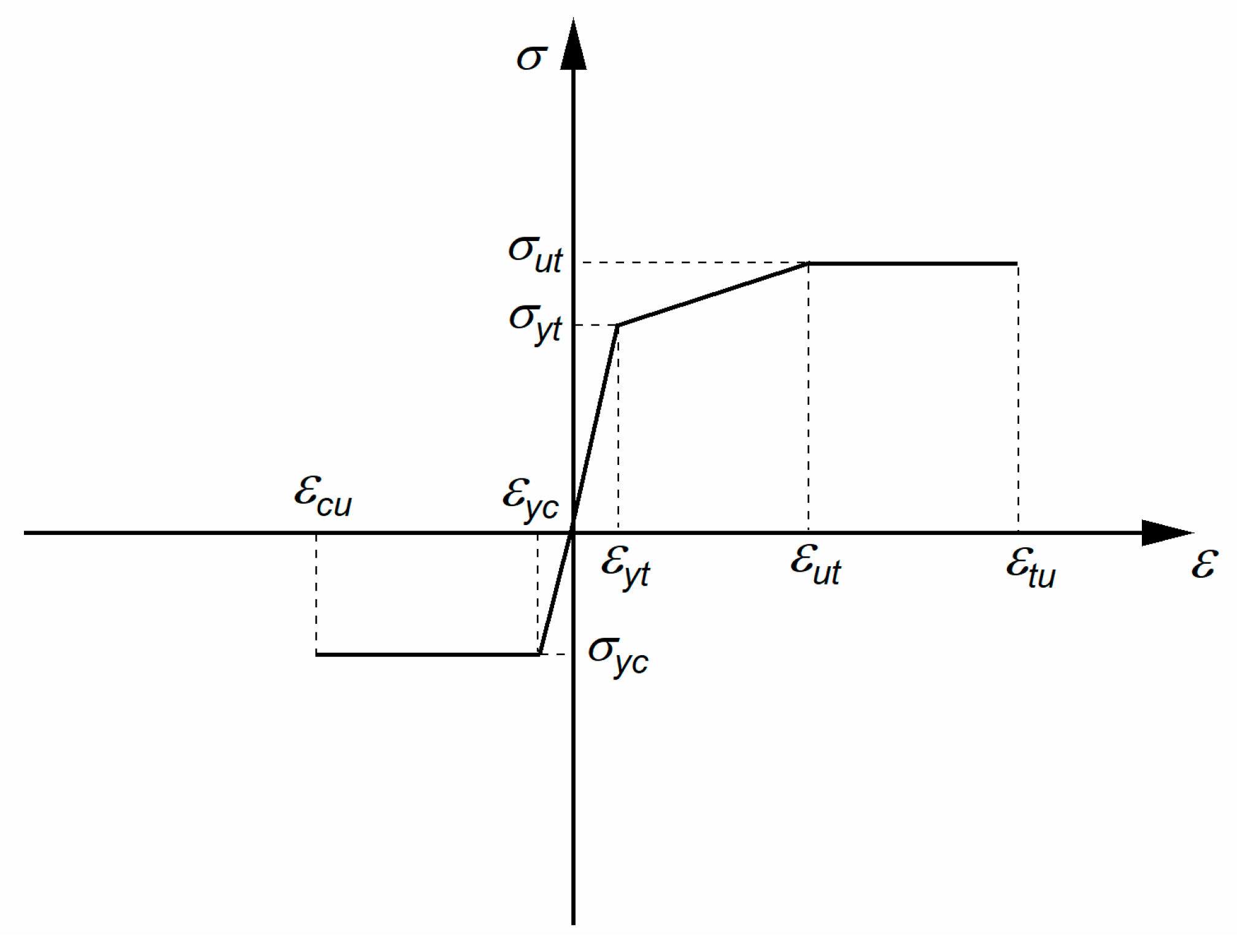
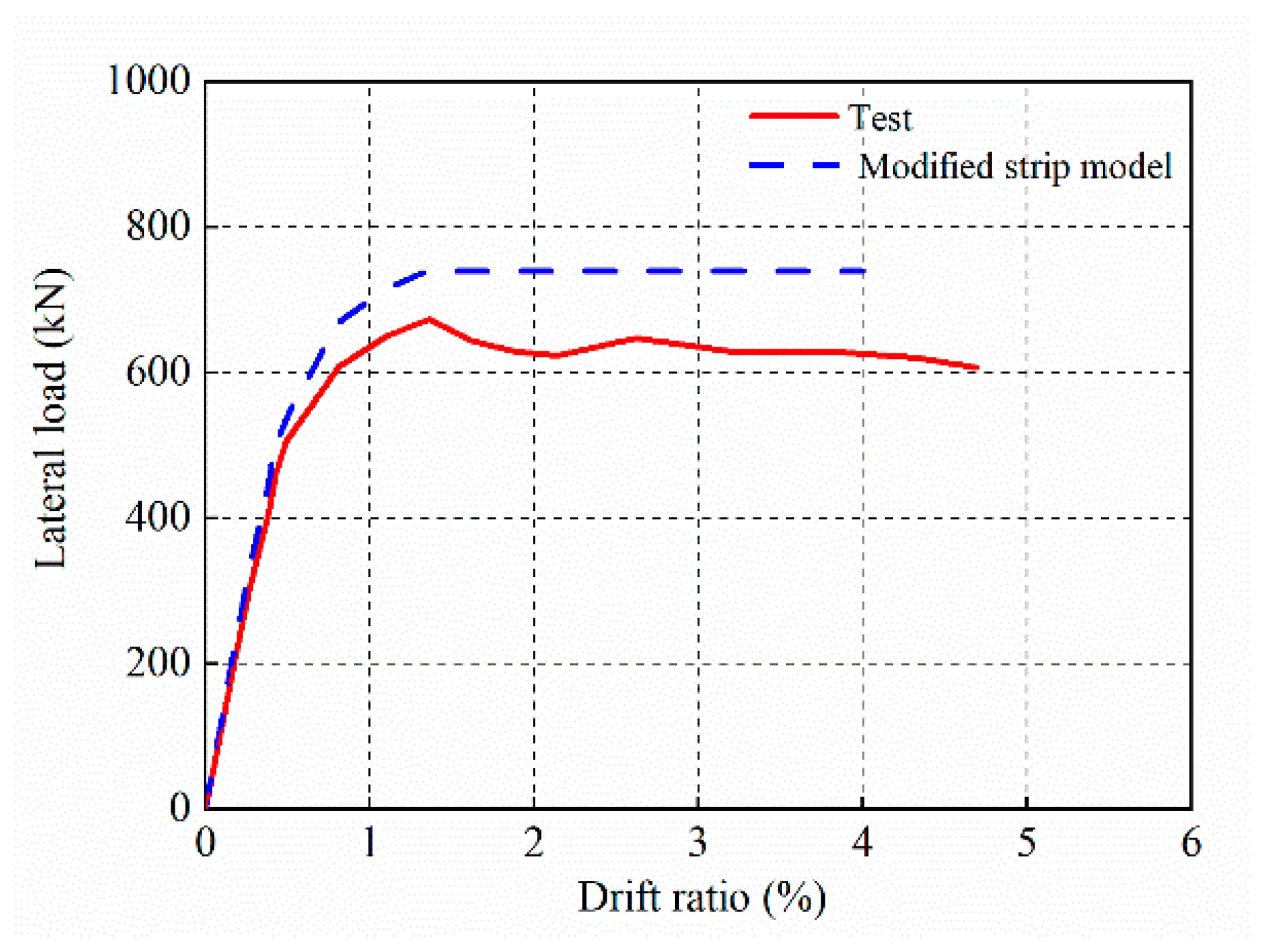
| Member | CSP Section | Frame Section | ||||||
|---|---|---|---|---|---|---|---|---|
(mm) | (mm) | (mm) | (mm) | (mm) | Column (mm) | Beam (mm) | ||
| CvW-1 | 100 | 3100 | 3100 | 77 | 110 | 77 | 700 × 700 × 70 × 70 | 700 × 700 × 70 × 70 |
| CvW-2 | 200 | 3100 | 3100 | 77 | 110 | 77 | 700 × 700 × 70 × 70 | 700 × 700 × 70 × 70 |
| CvW-3 | 300 | 3100 | 3100 | 77 | 110 | 77 | 700 × 700 × 70 × 70 | 700 × 700 × 70 × 70 |
| CvW-4 | 400 | 3100 | 3100 | 77 | 110 | 77 | 700 × 700 × 70 × 70 | 700 × 700 × 70 × 70 |
| CvW-5 | 500 | 3100 | 3100 | 77 | 110 | 77 | 700 × 700 × 70 × 70 | 700 × 700 × 70 × 70 |
| CvW-6 | 600 | 3100 | 3100 | 77 | 110 | 77 | 700 × 700 × 70 × 70 | 700 × 700 × 70 × 70 |
| CvW-7 | 800 | 3100 | 3100 | 77 | 110 | 77 | 700 × 700 × 70 × 70 | 700 × 700 × 70 × 70 |
| CvW-8 | 1500 | 3100 | 3100 | 77 | 110 | 77 | 700 × 700 × 70 × 70 | 700 × 700 × 70 × 70 |
| CvW-9 | 300 | 3100 | 1550 | 77 | 110 | 77 | 970 × 970 × 97 × 97 | 970 × 970 × 97 × 97 |
| CvW-10 | 300 | 3100 | 4650 | 77 | 110 | 77 | 970 × 970 × 97 × 97 | 970 × 970 × 97 × 97 |
| CvW-11 | 300 | 3100 | 6200 | 77 | 110 | 77 | 970 × 970 × 97 × 97 | 970 × 970 × 97 × 97 |
| CvW-12 | 300 | 3100 | 7750 | 77 | 110 | 77 | 970 × 970 × 97 × 97 | 970 × 970 × 97 × 97 |
| CvW-13 | 300 | 3100 | 9300 | 77 | 110 | 77 | 970 × 970 × 97 × 97 | 970 × 970 × 97 × 97 |
| CvW-14 | 300 | 3100 | 3100 | 49 | 70 | 49 | 700 × 700 × 70 × 70 | 700 × 700 × 70 × 70 |
| CvW-15 | 300 | 3100 | 3100 | 63 | 90 | 63 | 700 × 700 × 70 × 70 | 700 × 700 × 70 × 70 |
| CvW-16 | 300 | 3100 | 3100 | 91 | 130 | 91 | 700 × 700 × 70 × 70 | 700 × 700 × 70 × 70 |
| CvW-17 | 300 | 3100 | 3100 | 106 | 150 | 106 | 700 × 700 × 70 × 70 | 700 × 700 × 70 × 70 |
| CvW-18 | 300 | 3100 | 3100 | 95 | 110 | 95 | 320 × 320 × 32 × 32 | 320 × 320 × 32 × 32 |
| CvW-19 | 300 | 3100 | 3100 | 95 | 110 | 95 | 360 × 360 × 36 × 36 | 360 × 360 × 36 × 36 |
| CvW-20 | 300 | 3100 | 3100 | 95 | 110 | 95 | 380 × 380 × 38 × 38 | 380 × 380 × 38 × 38 |
| CvW-22 | 300 | 3100 | 3100 | 95 | 110 | 95 | 450 × 450 × 45 × 45 | 450 × 450 × 45 × 45 |
| CvW-23 | 300 | 3100 | 3100 | 95 | 110 | 95 | 680 × 680 × 68 × 68 | 680 × 680 × 68 × 68 |
| ChW-1 | 300 | 3100 | 1550 | 77 | 110 | 77 | 970 × 970 × 97 × 97 | 970 × 970 × 97 × 97 |
| ChW-2 | 300 | 3100 | 4650 | 77 | 110 | 77 | 970 × 970 × 97 × 97 | 970 × 970 × 97 × 97 |
| ChW-3 | 300 | 3100 | 6200 | 77 | 110 | 77 | 970 × 970 × 97 × 97 | 970 × 970 × 97 × 97 |
| ChW-4 | 300 | 3100 | 9300 | 77 | 110 | 77 | 970 × 970 × 97 × 97 | 970 × 970 × 97 × 97 |
| Test | 550 | 1100 | 1100 | 45 | 30 | 45 | 200 × 200 × 8 × 12 | 250 × 200 × 12 × 14 |
| Member | CSP Section | Buckling Strength | |||||||
|---|---|---|---|---|---|---|---|---|---|
(mm) | (mm) | (mm) | (mm) | (mm) | FE Model | Theory | |||
| CvW-24 | 13 | 110 | 77 | 77 | 3100 | 3100 | 0.85 | 0.92 | 1.08 |
| CvW-25 | 40 | 200 | 141 | 141 | 3100 | 2928 | 0.96 | 1.00 | 1.05 |
| CvW-26 | 48 | 200 | 141 | 141 | 3100 | 2928 | 0.82 | 0.77 | 0.94 |
| CvW-27 | 48 | 400 | 282 | 282 | 3100 | 3128 | 0.99 | 1.00 | 1.01 |
| CvW-28 | 64 | 400 | 282 | 282 | 3100 | 3128 | 0.96 | 1.00 | 1.04 |
| CvW-29 | 80 | 400 | 282 | 282 | 3100 | 3128 | 0.93 | 1.00 | 1.07 |
| CvW-30 | 97 | 400 | 282 | 282 | 3100 | 3128 | 0.89 | 1.00 | 1.13 |
| CvW-31 | 80 | 400 | 282 | 282 | 3100 | 3128 | 0.80 | 0.80 | 1.00 |
| CvW-32 | 101 | 500 | 353 | 353 | 3100 | 3912 | 0.85 | 0.92 | 1.08 |
| CvW-33 | 141 | 500 | 353 | 353 | 3100 | 3912 | 0.94 | 1.00 | 1.07 |
| CvW-34 | 24 | 600 | 424 | 424 | 3100 | 6744 | 0.68 | 0.55 | 0.81 |
| CvW-35 | 72 | 600 | 424 | 424 | 3100 | 6744 | 0.81 | 0.98 | 1.15 |
| CvW-36 | 85 | 600 | 424 | 424 | 3100 | 6744 | 0.87 | 0.89 | 1.02 |
| CvW-37 | 145 | 600 | 424 | 424 | 3100 | 6744 | 1.00 | 1.00 | 1.00 |
| CvW-38 | 170 | 600 | 424 | 424 | 3100 | 6744 | 0.64 | 0.54 | 0.83 |
Disclaimer/Publisher’s Note: The statements, opinions and data contained in all publications are solely those of the individual author(s) and contributor(s) and not of MDPI and/or the editor(s). MDPI and/or the editor(s) disclaim responsibility for any injury to people or property resulting from any ideas, methods, instructions or products referred to in the content. |
© 2023 by the authors. Licensee MDPI, Basel, Switzerland. This article is an open access article distributed under the terms and conditions of the Creative Commons Attribution (CC BY) license (https://creativecommons.org/licenses/by/4.0/).
Share and Cite
Cao, Q.; Huang, J. Shear Behavior and Analytical Method of Vertically Corrugated Steel Plate Shear Walls with Inelastic Buckling of Infilled Plates. Buildings 2023, 13, 2184. https://doi.org/10.3390/buildings13092184
Cao Q, Huang J. Shear Behavior and Analytical Method of Vertically Corrugated Steel Plate Shear Walls with Inelastic Buckling of Infilled Plates. Buildings. 2023; 13(9):2184. https://doi.org/10.3390/buildings13092184
Chicago/Turabian StyleCao, Qiang, and Jingyu Huang. 2023. "Shear Behavior and Analytical Method of Vertically Corrugated Steel Plate Shear Walls with Inelastic Buckling of Infilled Plates" Buildings 13, no. 9: 2184. https://doi.org/10.3390/buildings13092184




